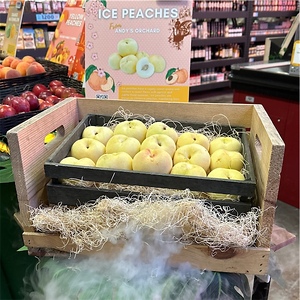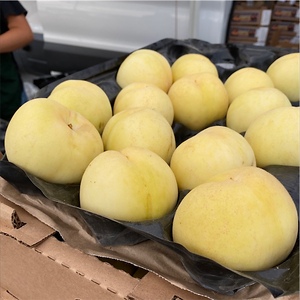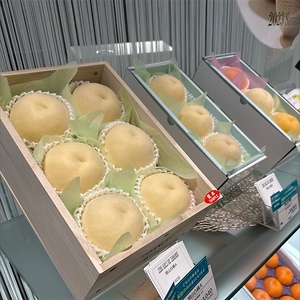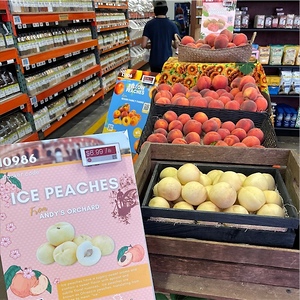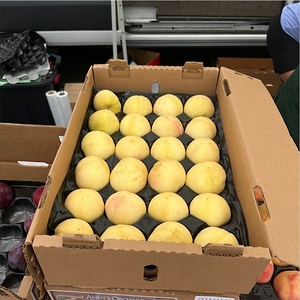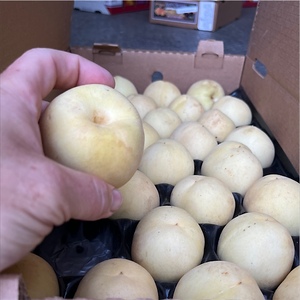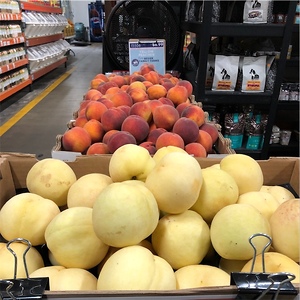


Ice Peaches
Estimated Inventory, cs : 0
Description/Taste
Ice peaches are a medium to large varietal, averaging 8 to 11 centimeters in diameter, and have a somewhat uniform, round to oblate shape. The fruit’s skin is pale yellow to ivory, smooth, taut, semi-thick, and fuzz-less, and there is a prominent suture extending from the stem to the base. Underneath the surface, the flesh is generally white and lacks pigment with a very firm, crisp, and aqueous consistency. The flesh also encases a tightly adhered, clingstone brown pit that should be discarded before consumption. Ice peaches weigh approximately 100 to 200 grams when ripe and are known for their low acidity and high sugar content, ranging from 19 to 22 Brix, a measurement of sugar within the fruit’s flesh. The fruits have a sugary-sweet aroma and contain a sweet flavor with apricot and subtle floral nuances. In addition to the pale fruits, Ice peach trees also produce showy light pink blossoms in the spring.
Seasons/Availability
Ice peaches are available in the mid-summer through the fall.
Current Facts
Ice peaches, botanically classified as Prunus persica, are a modern Italian cultivar belonging to the Rosaceae family. The sweet fruits grow on compact, dwarf trees that reach 1 to 2 meters in height and were developed in the early 21st century to showcase improved growth characteristics, appearance, and flavor. Ice peaches are known as Ghiaccio peaches, translating from Italian to mean “Ice.” The peaches are also sometimes known as Italian Ice peaches and Ivory peaches. There are currently three different types of Ice peaches generally sold under the same name in commercial markets. Each variation is categorized using the cultivar’s Italian name, Ghiaccio, with Ghiaccio-1 being the earliest ripening of the three, followed by Ghiaccio-2 and Ghiaccio-3. There is also a rumored Ghiaccio-0 that was developed five years after the original three that ripens even earlier than Ghiaccio-1. Ice peaches are specialty fruits highly favored for their durability, consistent flavor and texture, resistance to disease, and slow-ripening times. The fruits have the unique trait of ripening and remaining on the tree for an extended period of approximately 25 days without suffering a decline in flavor or textural quality. Ice peaches are also a valued home garden variety for the tree’s compact nature. The fruits can be consumed fresh or incorporated into any recipe calling for white peaches.
Nutritional Value
Ice peaches are an excellent source of antioxidants, including vitamin C, to strengthen the immune system, reduce inflammation, and protect the body against external environmental aggressors. The fruits also contain fiber to regulate the digestive tract, potassium to balance fluid levels within the body, vitamin E to protect the cells against free radical damage, and other amounts of magnesium, vitamin K, copper, zinc, and folate.
Applications
Ice peaches have a sweet, subtly fruity flavor that can be incorporated into most preparations calling for white peaches. The fruits can be consumed straight, out of hand, discarding the pit, or they can be sliced into green and fruit salads, chopped into salsa, stirred into grain bowls, or used as a fresh topping over yogurt, cereal, pancakes, or ice cream. Ice peaches can also be layered onto cheese boards, added to smoothies, frozen and blended to create an icy treat, or cut and dropped into fruit punches, lemonades, and sangria. In addition to fresh preparations, Ice peaches can be simmered into syrups, sauces, jams, jellies, and compotes, or they can be blended into sorbet. The fruits can also be grilled, baked, or sauteed with sweeteners and spices, or they can be cooked into cobbler, crisps, tarts, scones, and pies. Ice peaches pair well with roasted meats such as poultry, turkey, and pork, shellfish, herbs including mint, basil, and thyme, citrus, balsamic, coconut, vanilla, cinnamon, ginger, and cheeses such as feta, ricotta, and brie. Whole, unwashed, and ripe Ice peaches will keep 2 to 3 weeks when stored in the refrigerator. Once sliced, the peaches will keep 3 to 4 days in a sealed container in the fridge, or they can be frozen for extended use.
Ethnic/Cultural Info
Ice peaches are often featured at the annual Pomological Exhibition in Rome, Italy. The event is hosted by the Experimental Institute for Fruit Growing in Rome, a branch under CREA, an acronym representing the merging of CRA, the Council for Agricultural Research, and INEA, the National Institute of Agricultural Economics. The two Italian institutions were merged in 2015, focusing on breeding, researching, and releasing new fruit cultivars. The Pomological Exhibition is held in July and September and offers the public, horticulturalists, and specialty growers the opportunity to experience the varieties that the institution has created. Ice peaches are displayed and sampled at the exhibition and are commonly a crowd favorite for their unique appearance and sweet flavor.
Geography/History
Ice peaches were developed in Rome, Italy, at the Experimental Institute of Fruit Growing, now known under the institution name CREA. The variety was created by plant breeders Dr. Luigi Conte and Antonino Nicotra and was selected from years of crosses between peach varieties from China, Korea, Japan, and Italy. The breeding began in 1988 and continued through 1993. Once the variety was selected, it was released for commercial cultivation sometime around 2002. In 2007, another variation of Ice peach was also released, known as Ghiaccio-0. Today Ice peaches are grown throughout Italy and Europe are also cultivated by specialty growers and home gardeners in the United States. When in season, the rare cultivar is primarily sold through farmer’s markets and select distributors. The Ice peaches in the photograph above were grown through Andy’s Orchard in Morgan Hill, California.
Recipe Ideas
Recipes that include Ice Peaches. One







